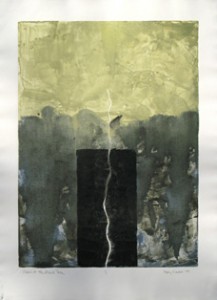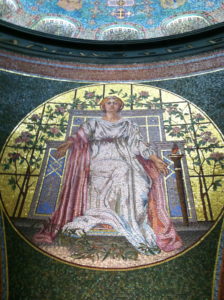 “What do you see, Jeremiah?” (Was this the first teaching using a visual aid?) God gets Jeremiah’s attention. God, the original socratic prompter puts His young prophet in the uncomfortable position of having to search out an answer. Jeremiah blurts out the obvious. (Were they literally having a conversation, did Jeremiah hear audible words? All I know is there was a very specific dialogue going on, and it is important enough to have been recorded.) Jeremiah answers, “I see a rod of an almond tree.” There was something physical they were looking at then. Jeremiah needed help understanding. Maybe there was a pause; pauses are pregnant with God. Maybe Jeremiah kept looking at this almond branch, wondering to himself “what in the world…” God breaks in then “You have seen well, for I am watching over my word to preform it.” And that is all we have in that beginning of their long relationship.
“What do you see, Jeremiah?” (Was this the first teaching using a visual aid?) God gets Jeremiah’s attention. God, the original socratic prompter puts His young prophet in the uncomfortable position of having to search out an answer. Jeremiah blurts out the obvious. (Were they literally having a conversation, did Jeremiah hear audible words? All I know is there was a very specific dialogue going on, and it is important enough to have been recorded.) Jeremiah answers, “I see a rod of an almond tree.” There was something physical they were looking at then. Jeremiah needed help understanding. Maybe there was a pause; pauses are pregnant with God. Maybe Jeremiah kept looking at this almond branch, wondering to himself “what in the world…” God breaks in then “You have seen well, for I am watching over my word to preform it.” And that is all we have in that beginning of their long relationship.
God makes His point with a simple natural object. The almond branch is a symbol that signals substance. And with this frail object, God offers an incontrovertible guarantee. I so love this, for pregnant are His words still remaining, yet He is watching over every one. There is so much that Jeremiah heard and reported from what God said to him, and so much of that is even yet to be seen on the ground. There are hard words and there are amazingly hopeful words, “to build and to plant,” “to give you a future and a hope…” But this first assurance clearly puts God in the driver’s seat. It puts God taking the responsibility for the faithful executing of every word He has ever said. He is clear that He is actively watching over the sprouting of His consummating work. Long after Jeremiah’s time then, I sit pondering the faithful words, from the faithful word giver. From these amazing assurances does my hope come. I did this monotype in ’08, “Sign of the Almond Tree.” It just came back from Philadelphia. I am so glad to see this again.
 This is not empty wishing; it is solid unseen trust.
This is not empty wishing; it is solid unseen trust. Think about it, your body is a very dark place on its own. When scopes go into our bodies they must bring their own light, like miner’s lamps, to be able to see anything. When bodies are on surgical tables they are dark chasms until the surgeon’s knife cuts open flesh and the huge lights over the table light up what was hidden and all closed in. We only see these things because our eyes have taken in light first. This is simply true, and the physical is a signal/type for what is more important, the spiritual. Looking into someone’s eyes is often so intuitively instructive as to whether there is any life or light in there. According to Jesus, for any light to be inside us, we have to let it in, we have to allow our lamps to be lit. We cannot come forth with light on our own. Light was the 1st creative accomplishment in Genesis and it comes forth from God. This is basic though I stumble over it.
Think about it, your body is a very dark place on its own. When scopes go into our bodies they must bring their own light, like miner’s lamps, to be able to see anything. When bodies are on surgical tables they are dark chasms until the surgeon’s knife cuts open flesh and the huge lights over the table light up what was hidden and all closed in. We only see these things because our eyes have taken in light first. This is simply true, and the physical is a signal/type for what is more important, the spiritual. Looking into someone’s eyes is often so intuitively instructive as to whether there is any life or light in there. According to Jesus, for any light to be inside us, we have to let it in, we have to allow our lamps to be lit. We cannot come forth with light on our own. Light was the 1st creative accomplishment in Genesis and it comes forth from God. This is basic though I stumble over it.